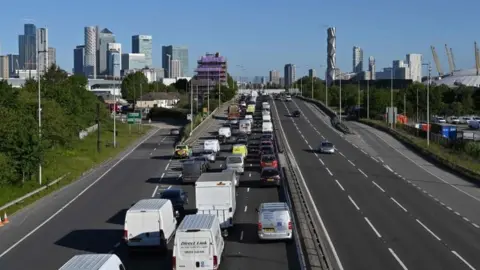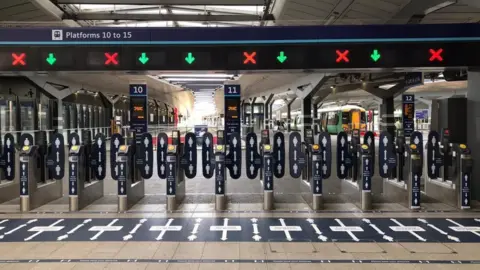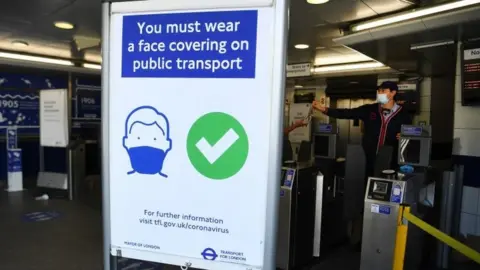Coronavirus: Public transport systems face an uncertain future

 AFP
AFPHow can mass transit survive when it can't carry high numbers of passengers? That is the question vexing the authorities.
Most of the time trains and buses are operating with social distancing and sometimes they seem to be running very empty. Those who are travelling on them wear masks and some are still reticent to use public transport.
That doesn't look like changing very much and it's very much what the authorities want to see in the short to medium term.
The messaging hasn't changed from "avoid public transport unless absolutely necessary". Arguably the language has softened a little from only "essential" journeys to "necessary".
Already car journeys are rising.
In the congestion charging zone, the number of cars is already what it was before lockdown - 100,000 a day.
The congestion charge zone fee has increased to try and combat that. The fear is that in London that will continue to grow and any recovery will be car-led with the associated pollution.
 AFP
AFPBut the number of people cycling and walking has also jumped in the capital leading to some councils to start low traffic neighbourhoods and school streets to further restrict motor vehicles.
In Brixton, Lambeth Council has stopped traffic going through areas around Railton Road, where 5,000 vehicles a day were passing along one residential road. And while many local residents like the idea, there is a sizeable number who are against the restrictions.
What is also interesting is the funding for these emergency interventions are part of the government's bailout of Transport for London (TfL).
A condition of the bailout is the money which is being given to councils via TfL, can only be used on this type of cycling and walking scheme.
You can expect to see more of this trend. Perhaps the number of e-scooters will continue to increase.
 EPA
EPAFigures showed 50% of Londoners used public transport to get around before the lockdown began. And the concern is running Tubes and trains which are only partially full is not sustainable.
What has also changed is the social distancing and that will help with capacity a little. According to TfL's modelling, going from 2m to 1m will increase capacity to 25%, from 15%.
While a normal Tube train can normally carry 800 people (or even more), at 2m that reduces to 93, while at 1m plus a train can carry 208, the figures show.
A double-decker bus can carry 87 passengers. At 2m social distancing it can carry 20, at 1m plus it can carry 30. There will also be an impact on queues, making them shorter.
But all the transport unions have concerns about reducing social distancing.

Rail companies have welcomed the news that social distancing will be cut to 1m plus. But they have warned the capacity will be full even at 1m by late November. After that you would have to manage and suppress the excess demand through messaging or pricing.
Michael Holden is a rail expert and a veteran who once ran rail companies for government and he says the situation is unsustainable. The railways have already cost £3.5bn in government money and that could rise to £7bn.
He thinks the messaging around trains being for "essential journeys only" has to change and there is a way to make public transport safer by introducing more extensive cleaning, plastic screen barriers and possible automatic temperature checks.
And there are many who think public transport should be looking at the aviation industry and copying the techniques they are using to make flying safer.
At London City Airport, it is now using automatic temperature measuring systems on entering the terminal and computer software highlights areas where social distancing isn't being met.
Could we see some of that copied on public transport?
 EPA
EPAAnd the big question is funding. How long can the government heavily subsidise public transport? In London the £1.6bn bailout runs out in September.
Grant Shapps, the transport secretary, told the Transport Committee last week that it was "fairly obvious if you're not running at 100% capacity it is very difficult to make it profitable".
More home working is one way to relieve the public transport system. And there may be a push to encourage that even more. Some firms are considering closing offices and getting workforces to work from home.
But public transport hasn't really addressed yet how it will deal with large numbers returning or if indeed that is even possible.
